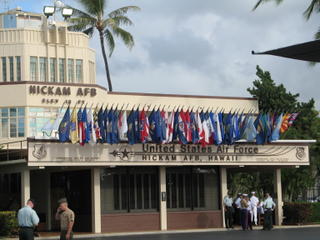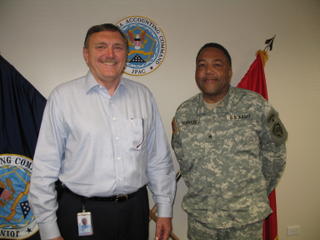A marching general, an honor guard, and a transport plane for a hero’s return
Wednesday, October 26th, 2005
When my father’s plane was shot down by German anti-aircraft fire five months after he arrived in Europe, our family was told that we would never know what happened on that day, much less expect to have him returned to us. This summer in Elsnig, I gathered fewer actual remains as precious pieces of information about my father’s last flight. Last week in Hawaii at Hickam Air Force Base, I waited on the runway for my father to be placed reverently on American soil once again.
It was a beautiful Honolulu morning, not yet as humid as it would become but Hickam is stunning with history and pristine beauty regardless of the weather. I had received the fully escorted tour of JPAC the day before which included a visit to the famous Central Identification Lab. Among the people I met again who have been essential to the success of my search and recovery efforts, was my dear patient friend and lifeline to JPAC, Johnie Webb. For me, he is to JPAC what Hans-Guenther is to aircraft parts. After being welcomed by him with a big Texas hug, the first thing he told me that my father’s name would soon be added to the Homecoming Commemoration wall behind us. It was filled with tiny brass name plates of the 1300 formerly-missing that JPAC has identified and returned home. Each tiny plaque represented a life story and my father’s is now one of them.
I have always been fascinated by forensics and I suppose that is why I find the study of people so endlessly fascinating. We are not so different in death, I noticed as I observed the bones in the lab, only more quiet. There is definitely an energy emanating from them in their perfect state of protection under JPAC’s watchful eye. 1100 active and inactive cases are catalogued and stored there, many of them, unsolvable. The table holding the familiar results of our work in the Elsnig field was the second from the front on the far right. The bones and small things we found appeared as a shimmering mirage through the glass. I saw them first in the sifted dirt in Elsnig. I knew them intimately,and I recognized them as my legacy and responsibility. The other tables were heavy with nearly whole skeletons. Bones are the honored guests here and attention to detail and security for these precious remains is an obvious and serious part of JPAC’s work.
The ever-present and devoted Der Spiegel crew, Christopher, Theo, and Phillip, had braved a 30-hour nightmare in flying and lost luggage to join me in Hawaii and were already filming and setting up interviews. I tried to string together cohesive answers to Christopher’s question. but the experience of being at JPAC, seeing the famous lab and being with my father’s remains again, was overriding any logic or continuity. I had been warned by the team in Elsnig that this place, representing the reclamation of the indescribable results of death in war, would be humbling. It was that and more. I’ve seen many of the world’s wonders, but the Central Identification Lab is the most wonderful. Tender exacting work is done there with highest respect and consideration. Their business is to name the long-dead and lost and connect them, if possible, to those who wait. Hope and joy coexists with death and loss. These are the seekers of the messages in the bones and identifiers of the artifacts of a life. Everyone should visit there at least once to examine their own mortality, if nothing else.
After visiting the lab, I saw my friend, Chris McDermott, JPAC historian, with whom I’d been corresponding for several years and finally met in Germany last summer. He is also a good friend of Hans-Guenther’s and is to history what Hans-Guenther is to aircraft parts. In the JPAC archives he introduced me to his wife, Heather Harris, who is the goddess of all saved things. (To describe them otherwise would be inadequate in light of the work they do and why) Heather told me that the archival boxes of files represented each case and would I like to see my father’s file?
His now-familiar Deceased File was in the beige box identified by his Missing Air Crew Report (MACR). As always, these collections of obscure information tend to include something new just when I think I’ve found it all. What was news to me this time was that my father wore a size 10 ½ shoe, had his appendix and three wisdom teeth removed, and was 5’11”. Those things are precious to know but I also saw the original typed correspondence written by my mother and my grandfather begging the government for information about my father. Each of their letters was attached to the same vague response: “We regret that no further information is available about your husband/son. and if/when we learn something new, you will be informed. No grave/body has been found and he is considered missing/killed in action.” My family couldn’t call that reassurance but it was how they finally accepted their loss. Reluctantly, they closed the door but not their hearts to the possibility that he would be found. Still wondering why I did this?
The Repatriation Ceremony was to begin at 9:00 the next morning, Friday, October 21. The Der Speigel crew drove us to Hickam so they could get a “how are you feeling today?” interview while I was a captive audience. I realized that I was at a loss to name what I was feeling except to offer up: happy, sad, proud, delighted, excited, anticipatory, joyous, near tears, in tears, hopeful, and all emotions connected to what some people like to call closure. (Tom Humphrey and I had a poster with drawings representing feelings on the wall in a hospital where we worked with teenagers - where was that damn poster when I needed it?) Mostly, I realized that my father’s bravery and my love for him brought us all to this place in time. I was grateful to whatever forces made this possible – genetic, angelic, magical, ethereal, or governmental.
We navigated the full parking lot near the runway where the ceremony would happen. Awaiting us in the first parking space, reserved for Dr. Sharon Estill Taylor (daughters have privilege), was a JPAC contingent including Johnie Webb and Major Nelson-Green, the PR officer. The airfield was full of uniformed people including two veterans groups representing Viet Nam and Korea, everyone who works at JPAC who weren’t in the field, and a couple hundred others. I was delighted and surprised to see Rodney Acasio and Shane Bellis, the only two from the Elsnig excavation team who weren’t away on the next mission. They had a major part in the reason we were there. They knew it and so did I. Another gift to me from JPAC.
An enormous C-130 transport plane was parked on the runway. Johnie Webb asked me if I wanted to go aboard to spend a few minutes with my father’s casket before the ceremony. As we walked up the metal ramps into the open bay, I saw a wash of red, silver, and blue. The red harnesses and seats attached to the walls of the plane exactly matched the stripes on the flags fitted around three silver transport cases, holding the remains of the repatriated. My father was in the middle. The scene before me defied description except as colors, stillness, and finality. The Der Spiegel crew remained at the back of the bay as I cautiously approached this long-awaited hard evidence that my mother and my father’s family never had.
As I touched the silver box holding my father’s remains, I felt only deep sadness at the injustice of his death. All the patriotic logic we’ve attached to why he died and for what cause, momentarily disappeared. Yet, I knew, despite my sadness, that my father’s flag draped presence represented all war losses and that it was what informed my life and shaped my destiny. I was reminded that those of us who experience losing a loved one in war share a fragile bond made of pride and certainty, despite our pain. It’s always nice to know something of your life’s purpose.
As we took our places under the VIP canopy for the ceremony, the transport plane was to our left, and a blue Medivac bus waiting to take the precious silver boxes back to the lab, was on the right. JPAC’s Commanding General and five other commanding officers marched into the space between, following the uniformed honor guard. We stood at attention three times while my father’s military brothers and sisters saluted each flag- draped life as it was carried from plane to bus. My job was to keep breathing and remain present in the moment.
The men who would bear my father’s remains entered the open bay for the second time and reappeared carrying the second silver box between them. Though all the flag draped cases were identical, this one was definitely mine. I stood with my hand on my heart and welcomed my father home.
The last one took its place in the bus and the doors were ceremoniously closed. A soldier stood at attention in front of the closed doors and very slowly raised his arm into a perfect salute. A long-awaited moment stopped time. Then I remembered to breathe.
Photographs of that morning fall short of the sense of honor present in the event. The same reverence and attention to detail is customary with JPAC and has been present in all of my dealings with them. When I met General Flowers (a fellow KU grad), I said that he could be very proud of the people who are JPAC. His reply was, “I am, and thank you for letting us help you bring your father home.”
When I brought JPAC this crash site a few years ago. I had no illusion that my discovery would supersede any of the other JPAC cases. But, what I received as I awaited my turn (sometimes not patiently) was copious information, support when I needed it, and the friendship of people who fully understood my mission because it was their mission, too.
This ceremony that JPAC gave my father in Hawaii last week was a dress rehearsal for Arlington in 2006. I should have my father’s remains returned to me by the end of the year.
I have always been a fortunate girl. The dad who stepped in to raise me used to say that I would fall into shit and come out smelling like a rose. There have been a few time when things weren’t always rosy but this wasn’t one of them. I believe that next to the wound is the lesson and opportunity. That’s all I did here – look beyond the obvious, disbelieve what I was told to accept as truth, and create the reality that I would bring my father home. Thanks for traveling with me this far. I’ll write as things get interesting and believe me when I say, they always do.





